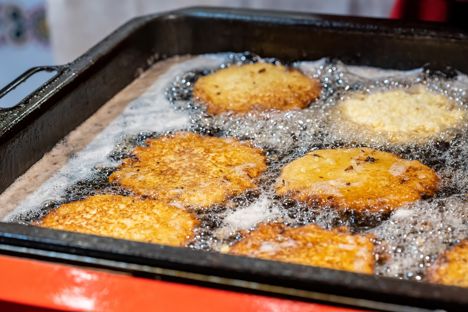
Taste the tradition: an introduction to Kashubian cuisine
The Northern Polish region of Kashubia is distinct from many other parts of the country, with its own language and a cuisine that’s unique to the area. We delve into Kashubia’s food traditions, taking a closer looks at some of the region’s most traditional dishes.
Taste the tradition: an introduction to Kashubian cuisine
The Northern Polish region of Kashubia is distinct from many other parts of the country, with its own language and a cuisine that’s unique to the area. We delve into Kashubia’s food traditions, taking a closer looks at some of the region’s most traditional dishes.
Stretching down from Poland’s coastal northern tip all the way to the lush forests and rolling hills found further inland, the region of Kashubia is up there with the country’s most picturesque. Its stunning scenery is just part of the region’s appeal though. Unlike anywhere elsewhere in Poland, the Kashubians have an incredibly unique culture and even their own language, spoken by a significant portion of the population. If you visit this part of the country, one of the things you’ll also quickly notice is the distinct cuisine cooked in local households and traditional restaurants.
Drawing heavily on the bounty of natural ingredients found within the region, the Kashubian kitchen is all about seasonal produce and simplicity. Perhaps unsurprisingly given the rivers, lakes and Baltic Sea coastline it has at its disposal, fish plays an important role in the cuisine, whether cooked, pickled or even turned into soup. Baltic Sea herring especially is a cornerstone of many Kashubian dishes with its rich, briny flavour. Other staples include duck and goose (served both cooked and, occasionally, raw), as well as mushrooms and berries, often foraged from the region’s extensive forests. Strawberries are a particular point of pride for the Kashubians, renowned for being exceptionally sweet and juicy. As a recognition of their quality, Kashubian strawberries were even granted protection by EU law in 2009, making them Poland’s first protected fruit.
Traditional Kashubian dishes
To fully understand Kashubian cuisine, it’s important to take a closer look at the region’s traditional dishes and recipes, many of which have been passed down through generations. Below are five of the dishes you’re most likely to come across if visiting the area.
One of the most famous dishes in Kashubian cuisine is śledzie po kaszubsku, or Kashubian-style herring. Showcasing the region’s love for Baltic Sea herring, it sees pre-salted fillets of the fish marinated in a flavourful sauce of sautéed onions, vinegar, tomato, spices and sugar. Fruit like apples and prunes are also commonly added to give the sauce a brilliant balance of sweet and tangy flavours. Once prepared, the sauce-covered herring is typically stored in jars and keeps for a number of weeks, making it a staple of many Kashubian homes.
Poland is famed for its vast array of wonderful soups and whilst you can find many of the classics such as zurek and czernina in Kashubia, it also has some specialities of its own. One of these is dziadówka, a simple soup made from potatoes, onions, buttermilk and bacon, which is blended to a silky smooth consistency and served hot. A traditional recipe which has been cooked for centuries, dziadówka is particularly popular during the colder months, as it provides both warmth and plenty of sustenance.
Potato pancakes known as plince are another hugely popular dish in the north of Poland, and are often enjoyed as a comfort food. Made from a batter of grated potatoes, onions, and sometimes a bit of flour, the pancakes are fried until crispy and golden brown before being served with a variety of different toppings. Most commonly sweet plince are served simply with a dusting of sugar, whilst sour cream is a classic savoury topping.
Ferkase is a dish that exemplifies the Kashubian love of poultry, specifically goose. This creamy stew is made from tender goose meat, or nowadays more commonly chicken, simmered with root vegetables, and enriched with a creamy roux-thickened sauce and sometimes also egg yolks. Some ferkase recipes also add in raisins or gooseberries to bring a touch of sweetness to the dish, while it’s typically served alongside a generous portion of rice.
When it comes to sweeter dishes, Kashubian drop scones known as ruchanki are an absolute must-try. Historically made using left-over bread dough, these fluffy yeasted pancakes are now usually made using flour and can be flavoured with cinnamon or vanilla. In Kashubia, ruchanki are traditionally served with apple but in this modern interpretation from chef Kuba Winkowski, he combines them with the flavour of Kashubia’s prized strawberries.
What better way to become even more familiar with Kashubian cuisine than visiting this beautiful region yourself? Check out our food guide to Sopot and Gdańsk to find out where you can sample everything from the traditional dishes mentioned above, to modern interpretations of this unique Polish cuisine.

